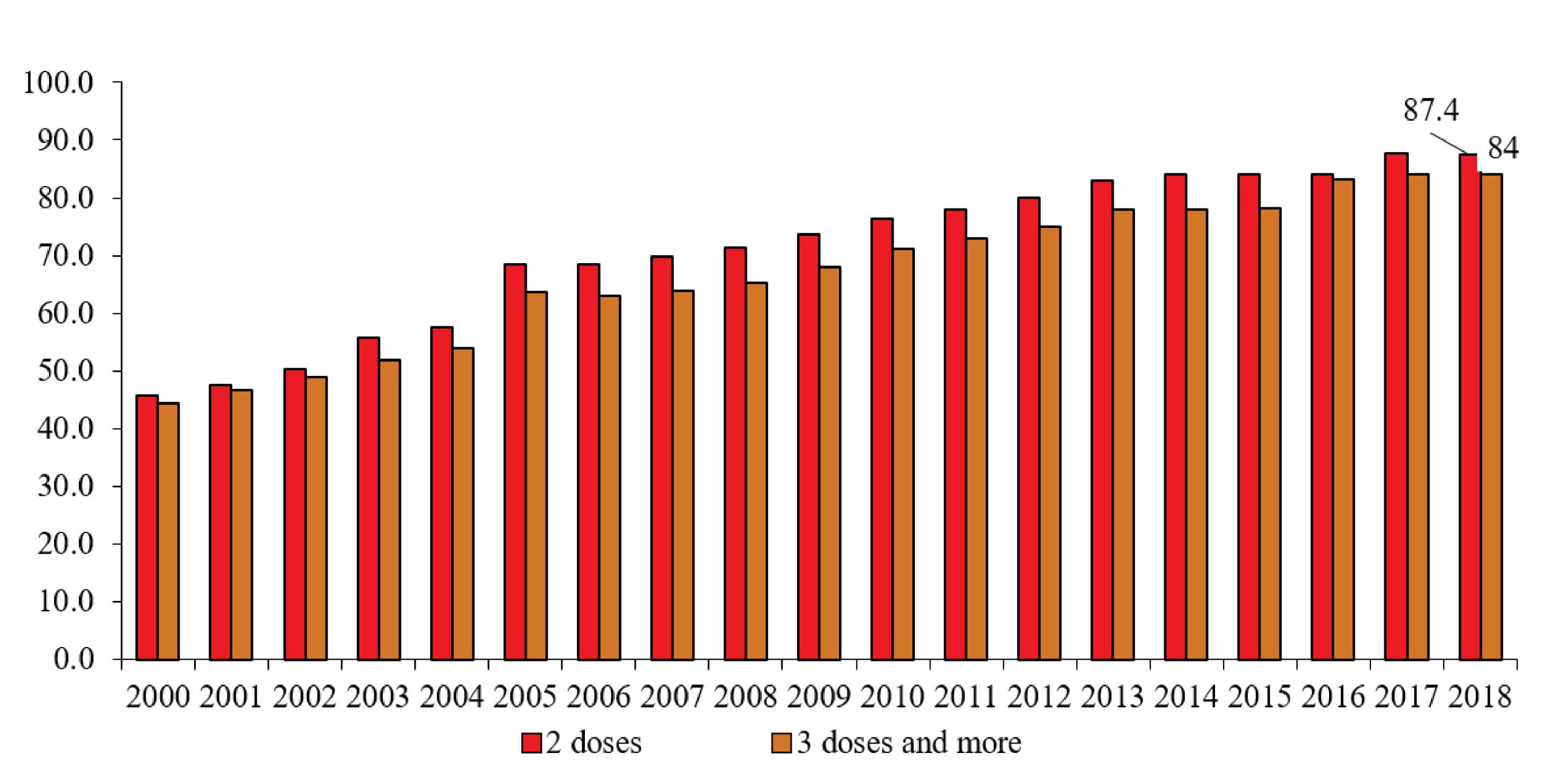Sergey Tkachev, Maria Esyunina and Maria Syrochkina
E-CDC risk status: endemic
(data as of end 2023)
Tick-borne encephalitis (TBE) was first revealed in the Far-East Taiga Forest in the Soviet Union in the spring-summer season 1933-19351 and further investigated as of 1937 in a large multidisciplinary expedition led by Professor Lev Zilber, the Head of the Moscow Medical Virology laboratory.2,3 The expedition demonstrated that the disease develops in humans after a tick-bite,4 and the “Taiga Tick” Ixodes persulcatus was established as the virus carrier. The viral etiology of the disease was confirmed and for the first time a strain of the TBE virus (TBEV) was isolated. The natural clinical disease spectrum in humans and the respective pathology were described and the effectiveness of “immunoglobulin-therapy” was demonstrated.5 In 1937, based on morphological studies TBE was assigned to the group of neuro-infections as an independent nosological entity.6,7
Vaccines against TBE have been available in Russia since 1939. Already in 1938 Kagan et al. developed the first mouse-brain propagated, formalin-inactivated vaccine from the Far East TBEV subtype “Sof’in” (1st generation of vaccines).8,9 Vaccine field effectiveness was established at the level of 98%, but the vaccine frequently induced serious adverse events. Another vaccine, a live attenuated product based on the Elantsev strain had not been licensed due to severe complications (encephalitis) in the vaccinated group.10 In 1950-1960 a 2nd generation of TBE vaccine was introduced which used chicken embryonic cell culture for virus reproduction.11 Finally, in the 1980s another new type of TBE vaccine was licensed in Russia which is currently still in use – a concentrated purified lyophilized 3rd generation vaccine.12,13
Only two species of ticks are epidemiologically significant in Russia: Ixodes persulcatus in the Asian part and some additional areas in the Urals and European part (Sverdlovsk and Yaroslavl regions) and I. ricinus in the European part. In some regions, Dermacentor tick species were found to be the main TBEV vectors (for example, Dermacentor reticulatus (previously known as D. pictus) in Udmurtia14-19; D. silvarum and D. nuttalli in the Altai Republic20 and the Republic of Tuva21; D. reticulatus, and D. marginatus in the Zhiguliovsk Reserve, which is located in the central part of Russia and inhabited by three species of ticks (I. persulcatus, D. reticulatus, and D. marginatus), and the abundance and TBEV infection rate of Dermacentor ticks were found even to be higher than those of I. persulcatus (4.3% vs. 1.4%, respectively).22 Moreover, in a number of regions I. pavlovskyi ticks have been described as TBEV vectors.23,24
Currently, TBEV is subdivided into three main subtypes- the European (TBEV-Eu), the Far-Eastern (TBEV-FE), and the Siberian (TBEV-Sib). The Siberian subtype dominance of the TBEV (over 60% of endemic areas) in the Russian Federation has been demonstrated by numerous virological and molecular-genetic studies.25-27 The Far Eastern subtype is found predominantly in the Far East, although it has been found in other territories, including Western Siberia, where it has been detected also in the blood of patients with tick-borne encephalitis.28 The European subtype is most commonly found in the European part of Russia, although foci of the pathogen have been found in Western and Eastern Siberia.23,29 Also, two putative TBEV subtypes (Baikalian and “178–79-like” subtypes) were described in East Siberia near Lake Baikal.25,30 It is believed that TBEV-Eu infection usually results in a rather mild form of TBE with a case fatality rate of <2%, TBEV-Sib infection is believed to result in a generally mild illness associated with a non-paralytic febrile form of encephalitis with the tendency towards persistent TBE caused by chronic viral infection in some cases, and TBEV-FE infection causes the most severe forms of TBE.31 Importantly, viral subtype is not the only factor that may contribute to TBE severity, and both mild and severe cases of TBE could be associated with the infection by any of the TBEV subtypes.
Official reporting of TBE cases in the USSR started in 1944. Fluctuations in TBE incidence had been observed because of the changes within the natural and anthropogenic focies, increased exposure to infected ticks, changes in the social behavior (outdoors activities, extension of the “cultured” areas, etc.), advances in diagnostics and well-designed implemented preventive measures.18 Over time, two disease peaks were observed in Russia (Fig. 1).
| Table 1: TBE in Russia | |
|---|---|
| Viral subtypes, distribution | European, Siberian, and Far Eastern TBEV subtypes |
| Reservoir animals | Vertebrate reservoir animals assumed |
| Infected tick species (%) | 2,1% infected tick from people after tick bite 1,6% infected tick from natural foci32 |
| Dairy product transmission | Rare (goat, cow milk) |
| Mandatory TBE reporting | TBE case definition: The diagnosis of tick-borne encephalitis is made based on information about tick bite, outdoor activities in the TBE season (potential contact with natural foci), clinical course and the results of laboratory tests confirming the etiology of the disease. Laboratory criteria for case confirmation: The clinical diagnosis of TBE is considered confirmed in the following cases: – detection of IgM to the TBEV in blood serum in the acute period of the disease in conjunction with the detection of IgG in paired serum; – detection of a 4-fold or more increase in the IgG titer to the TBEV in paired serums, or seroconversion; – detection of a specific fragment of TBEV RNA in the blood and/or cerebrospinal fluid samples; – isolation of the TBEV. All TBE cases with laboratory confirmation are reported to the Rospotrebnadzor Virology is performed in ticks only – ELISA or multiplex PCR for TBEV, Borrelia burgdorferi sl, Anaplasma phagocytophilum, Ehrlichia chaffeensis / Ehrlichia muris Source: 3.3686-21 “Sanitary and epidemiological requirements for the prevention of infectious diseases”, Section XX “Prevention of tick-borne encephalitis” |
| Other TBE-surveillance | Endemicity definition: An administrative territory shall be considered endemic for TBE if the features provided for in one of the following subparagraphs of this paragraph are present together: 1) the presence of vectors of the TBEV (in natural and anthropourgic foci); laboratory-confirmed circulation of the TBEV or detection of TBEV antigen/RNA in ticks from natural foci and removed from humans; immunity to the TBEV in the unvaccinated population; immunity to the TBEV among animals, provided that ixodes ticks have been distributed in the territory for at least a 5-year period; 2) registration of laboratory-confirmed TBE cases in humans during active examination of febrile patients with undetermined diagnosis, patients with meningeal conditions and with symptoms of focal lesions of the brain and spinal cord of unknown etiology; the presence ixodes ticks in the territory; laboratory-confirmed presence of TBEV or TBEV antigen/RNA in ticks collected in natural foci and removed from humans; immunity to the TBEV in the unvaccinated population; 3) registration of confirmed TBE cases; the presence of ixodes ticks in the territory, the presence of the TBEV or TBEV antigen/RNA in ticks selected in natural foci and removed from humans; the presence of immunity to the TBE virus in the unvaccinated population. Source: 3.3686-21 “Sanitary and epidemiological requirements for the prevention of infectious diseases”, Section XX “Prevention of tick-borne encephalitis” |
| Special clinical features | 13.3% – TBEV meningoencephalitis or meningoencephalomyelitis 22.2% – TBEV meningitis 61.9% – fever + anti-TBEV IgM or IgG increase Case fatality rate is 1-2% Source: Andaev EI et al. Problems of Particularly Dangerous Infections 2023;1:6–16. [In Rus]. doi:10.21055/0370-1069-2023-1-6-16 |
| Registered vaccines | Russian TBE vaccines (available in the market): – Klesch-E-Vac for children 0.25 ml and for adults 0.5 ml; – TBE vaccine concentrated purified inactivated adsorbed culture dry 0.5ml (Chumakov’s Polio Institude); – EnceVir®Neo for children 0.25 ml, EnceVir ® for adults 0.5 ml (Microgen) European vaccines (not available in the market): – Encepur adult 0.5ml ; – Encepur baby 0.25ml (GSK); – FSME-IMMUN 0.5ml; – FSME-IMMUN junior 0.25ml (Pfizer) Source: http://chumakovs.ru/en/products http://www.microgen.ru/en/ |
| Vaccination recommendations and reimbursement | National immunization Calendar for epidemic indications (Order of the Ministry of Health of Russian Federation dated 06.12.2021 No. 1122n, part 2): endemic regions have the right to implement local immunization program (RegIP) with vaccination rates determined by financial conditions in the region (universal vaccination or vaccination of risk groups only – i.e. infants and elderly) Vaccination is indicated for: – Persons living in endemic areas (all ages) – Persons with occupational risk (forest workers, etc.) – Persons travelling to endemic areas Vaccinations against TBE is recommended for: – Persons under 18 years of age living in administrative territories endemic for TBE, with coverage of at least 95%; – Adult population living in administrative territories with a high risk of the disease, taking into account the differentiation of administrative territories according to the risk of infection of the population with the TBEV, with coverage of at least 95%; – Adult population, by type of activity or occupation associated with staying in natural stations, as well as in horticultures located in administrative areas endemic for TBE; – Populations travelling to administrative areas where TBE is endemic; – Persons associated with labor activities in administrative areas endemic for TBE (occupational risk groups), in particular, carrying out: agricultural, logging, irrigation and reclamation, construction, harvesting, fishing, geological, surveying, expeditionary, deratization, disinfestation works; excavation and relocation of soil, clearing and improvement of forests; – Persons whose activities are related to the use of the TBEV; – Persons carrying out other types of work associated with the threat of TBE contamination. A person who has received a completed course of vaccination and 1 (or more) revaccination is considered to be vaccinated against TBE. Source: Order of the Ministry of Health of Russian Federation dated 06.12.2021 No. 1122n “On approval of the national calendar of preventive vaccinations, the calendar of preventive vaccinations for epidemic indications and the procedure for preventive vaccinations” 3.3686-21 “Sanitary and epidemiological requirements for the prevention of infectious diseases”, Section XX “Prevention of tick-borne encephalitis” |
| Name, address/website of TBE National Reference Center | Irkutsk Anti-Plague Research Institute of Rospotrebnadzor, Irkutsk, Russian Federation http://irknipchi.ru |
Figure 1: TBE incidence in Russia (all regions, endemic and non-endemic) in 1944-2022 per 100 000 population
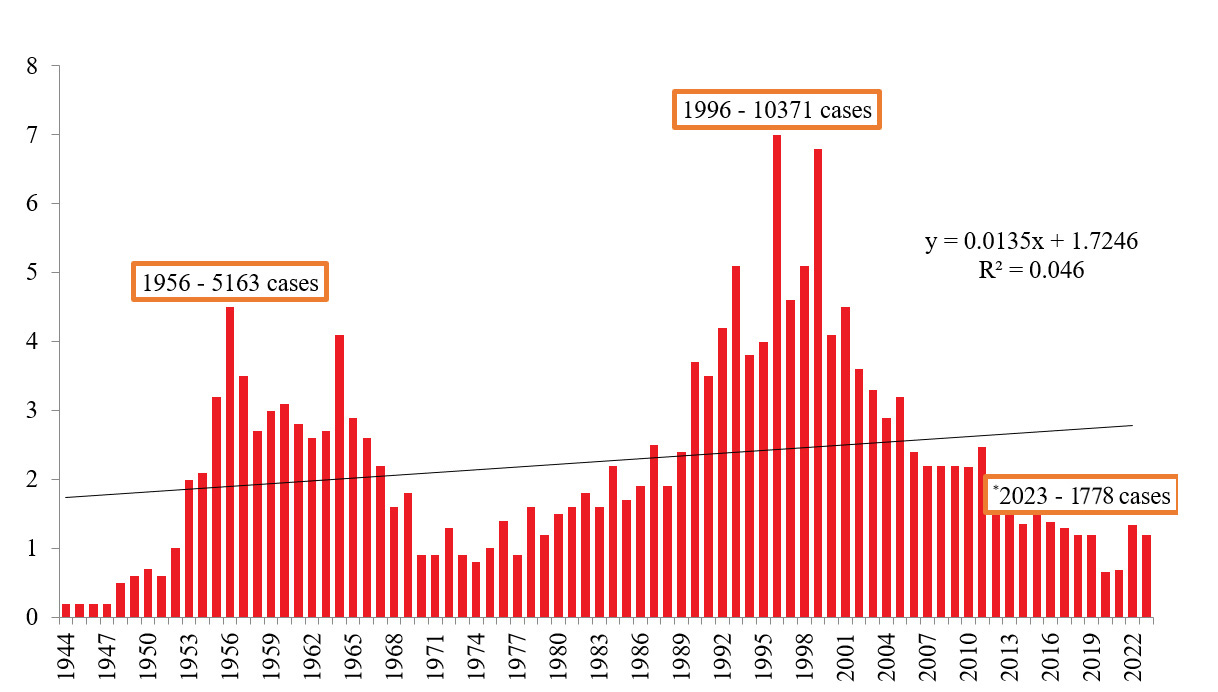
| Year | Number of Cases | Incidence / 105 |
|---|---|---|
| 1944 | n/a | 0.2 |
| 1945 | n/a | 0.2 |
| 1946 | n/a | 0.2 |
| 1947 | n/a | 0.2 |
| 1948 | n/a | 0.5 |
| 1949 | n/a | 0.6 |
| 1950 | n/a | 0.7 |
| 1951 | n/a | 0.6 |
| 1952 | n/a | 1 |
| 1953 | n/a | 2 |
| 1954 | n/a | 2.1 |
| 1955 | n/a | 3.2 |
| 1956 | n/a | 4.5 |
| 1957 | n/a | 3.5 |
| 1958 | n/a | 2.7 |
| 1959 | 3516 | 3 |
| 1960 | n/a | 3.1 |
| 1961 | n/a | 2.8 |
| 1962 | n/a | 2.6 |
| 1963 | n/a | 2.7 |
| 1964 | n/a | 4.1 |
| 1965 | n/a | 2.9 |
| 1966 | n/a | 2.6 |
| 1967 | n/a | 2.2 |
| 1968 | n/a | 1.6 |
| 1969 | n/a | 1.8 |
| 1970 | 1169 | 0.9 |
| 1971 | 1175 | 0.9 |
| 1972 | 1707 | 1.3 |
| 1973 | 1189 | 0.9 |
| 1974 | 1062 | 0.8 |
| 1975 | 1336 | 1 |
| 1976 | 1883 | 1.4 |
| 1977 | 1220 | 0.9 |
| 1978 | 2184 | 1.6 |
| 1979 | 1649 | 1.2 |
| 1980 | 2072 | 1.5 |
| 1981 | 2221 | 1.6 |
| 1982 | 2513 | 1.8 |
| 1983 | 2248 | 1.6 |
| 1984 | 3115 | 2.2 |
| 1985 | 2423 | 1.7 |
| 1986 | 2728 | 1.9 |
| 1987 | 3620 | 2.5 |
| 1988 | 2774 | 1.9 |
| 1989 | 3528 | 2.4 |
| 1990 | 5475 | 3.7 |
| 1991 | 5194 | 3.5 |
| 1992 | 6239 | 4.2 |
| 1993 | 7571 | 5.1 |
| 1994 | 5640 | 3.8 |
| 1995 | 5935 | 4 |
| 1996 | 10371 | 7 |
| 1997 | 6804 | 4.6 |
| 1998 | 7531 | 5.1 |
| 1999 | 10011 | 6.8 |
| 2000 | 6010 | 4.1 |
| 2001 | 6569 | 4.5 |
| 2002 | 5231 | 3.6 |
| 2003 | 4773 | 3.3 |
| 2004 | 4178 | 2.9 |
| 2005 | 4593 | 3.2 |
| 2006 | 3433 | 2.4 |
| 2007 | 3142 | 2.2 |
| 2008 | 3140 | 2.2 |
| 2009 | 3141 | 2.2 |
| 2010 | 3094 | 2.18 |
| 2011 | 3533 | 2.47 |
| 2012 | 2716 | 1.9 |
| 2013 | 2236 | 1.57 |
| 2014 | 1978 | 1.36 |
| 2015 | 2304 | 1.58 |
| 2016 | 2035 | 1.39 |
| 2017* | 1934 | 1.3 |
| 2018** | 1727 | 1.18 |
| 2019*** | 1775 | 1.21 |
| 2020 | 989 | 0.67 |
| 2021 | 1015 | 0.69 |
| 2022 | 1957 | 1.34 |
| 2023 | 1778 | 1.22 |
*Incidence for 2023 taken from: Nikitin YA et al (2024), https://doi.org/10.21055/0370-1069-2024-1-48-58
In the mid-1950s over 5000 cases were reported followed by a gradual decrease of the incidence until 1970. This was explained by human expansion into natural TBE foci as well as by considerable progress in establishing the diagnosis by improved laboratory methods. In 1965–1971 morbidity decreased year by year mainly due to broadly used acaricides (including DDT). From 1972 to 1991, however, morbidity increased again to the level recorded in 1964, perhaps because vector control had been canceled. Since 1992, a number of socioeconomic factors, including large-scale allotment of land for garden plots and the growing popularity of outdoor activities, have entailed a high risk of tick bites for the urban population. As a result, the TBE incidence reached the highest values ever recorded.19 TBE peaked in 1996 and 1999 with incidence rates in these years around 7.0 per 100,000 persons, resulting in more than 10,000 cases per year in the country.
Over the past 10 years, there has been a steady decline in the incidence of TBE in Russia, for the period 2012–2022, the average long-term incidence of TBE in the Russian Federation was 1.3 per 100,000 – a decrease of 9.7%. The share of children remained constant at 12–14% annually. Forty-eight Russian regions with a population of about 66 million people are endemic for TBE. The following federal districts play a decisive role in the formation of the incidence of TBE in the country: Siberian, Volga Federal District, Ural Federal District (Fig. 1, Fig. 2).
Figure 2: Ranking of territories of constituent entities of Russia according to the long-term average annual values of TBVE incidence per 100 thousand population (2012–2021)
1 – non-endemic territories; 2 – low level of epidemic risk (up to 0.79 ‱₀); 3 – medium level (from 0.8 to 3.37‱₀); 4 – high level of risk (more than 3.37 ‱₀)
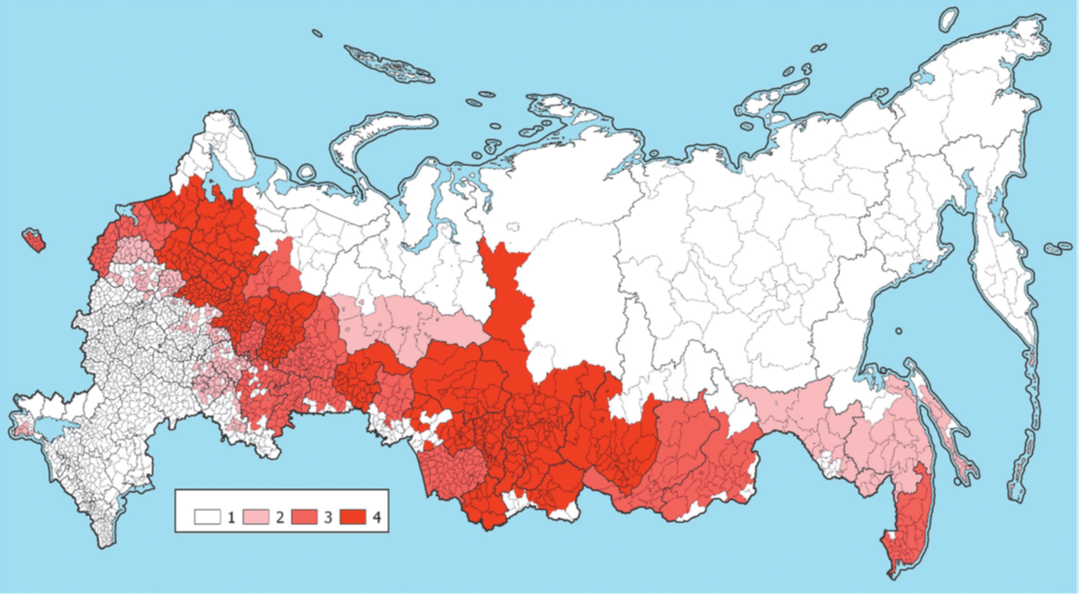
The Reference Center for Monitoring TBE ranked the regions of the Russian Federation by long-term average of the incidence of TBE in 2012–2021, which made it possible to distinguish groups of regions: 16 regions with high epidemiological risk; 14 regions with medium TBE incidence; 17 regions with low TBE incidence; 18 regions where TBE cases were not registered.30
To summarize the current TBE epidemiology data in Russia, in 2022 there were 502,764 visits to medical centers due to tick-bites (345,40 per 100,000), an increase of 12.6% compared to 2021 (446,282 visits) that is also 6.7% above the long-term average (469,950).32 Approximately 25% of the cases occurred in children.
In the 2022 epidemic season, from April to October, 331,972 ticks taken from humans after tick bite and 62,706 ticks from environmental objects were examined for the presence of TBEV markers by ELISA and RT-PCR tests. The rates of TBEV infected ticks in those removed from humans was 1.22% (long-term average: 2.12%); and in those from the environment it was 1.57% (long-term average – 1.42%) (Fig. 3).32
Figure 3: Dynamics of ticks infection rate (%), removed from people (A) and environmental objects (B); studied by ELISA and RT-PCR methods in 2015–2022: the left axis of ordinates, as studied by ELISA, corresponds to the red line; the right one, as studied by the PCR method, corresponds to the blue line
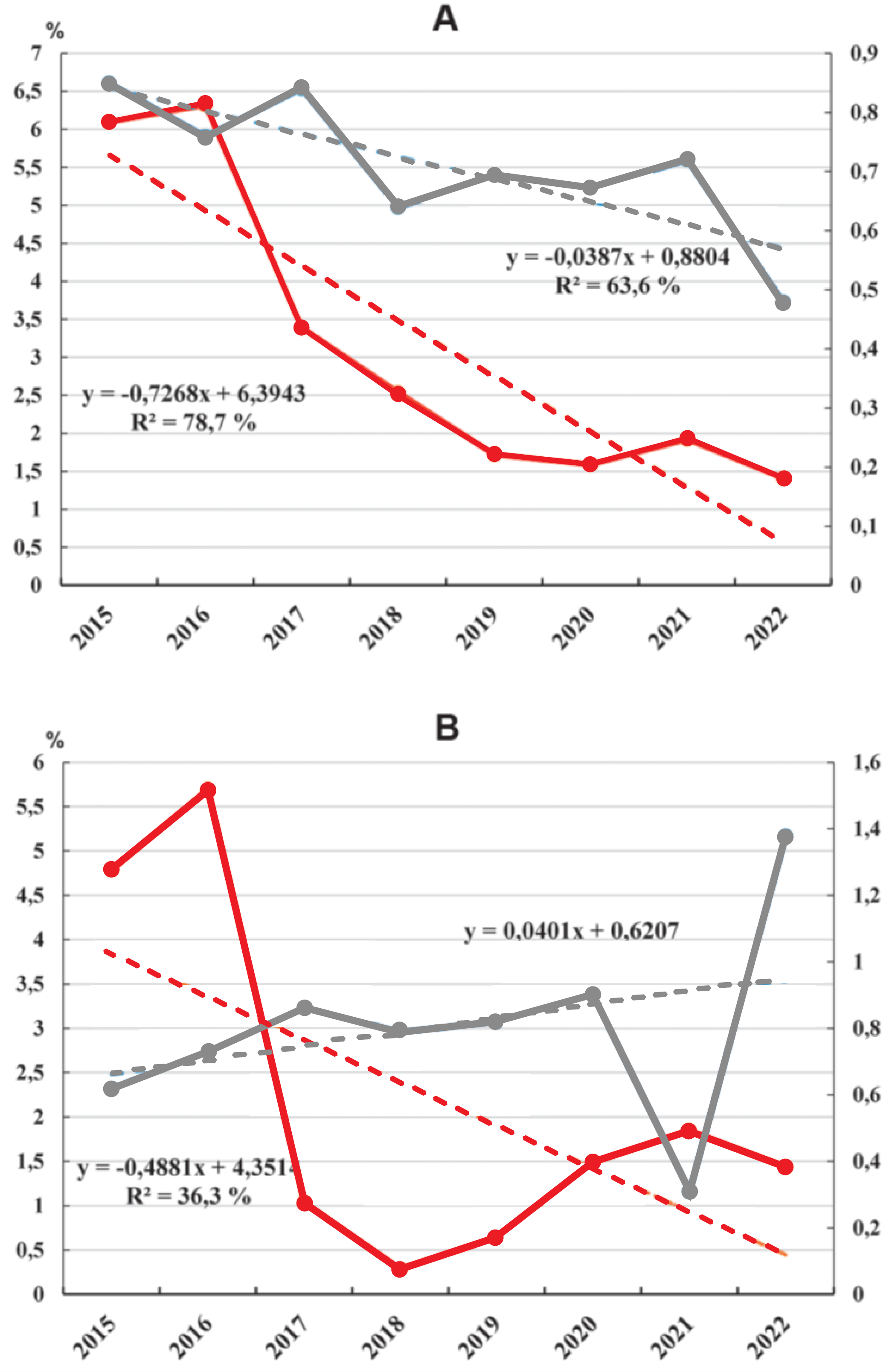
In 2022 TBE incidence in Russia almost doubled compared to the previous year (2021), amounting to 1.34 per 100 thousand population (in 2021 – 0.69 per 100 thousand population),33 1957 TBE cases were registered in 48 subjects, including 280 children under 17 years of age (0.92 per 100,000). In the structure of TBE cases, the age group of 50 years and older prevailed (47.2%), the share of children under 17 years of age was 14.2%, the urban population was 65.5%, and the rural population was 34.5%. The main route of transmission of TBE is by tick bites, 12 cases of alimentary route TBEV infection were registered.32
In the structure of TBE clinical manifestations, as in previous years, the febrile form prevailed (61.9%), the second most common form was meningeal (22.2%), and the share of focal forms was 13.3%.32 In the period 2007-2022 342 deaths from TBE were registered, in 2022 – 60 deaths, in 2021 -17 deaths.33-36
In 2022, 3.5 million people were vaccinated against TBE (1,153,697 vaccinated and 2,347,877 revaccinated). At the same time, 34 cases of the disease were registered in vaccinated persons (11 of them in children), which constitutes 1.7% of the total number of cases.32
Nonspecific prevention is common to all tick-borne infections: acaricidal treatment of endemic territories by special substances (cipermetrin 25% or analogues) is regarded to be the main measure nowadays.37 In Russia, in 2012–2022 there was a trend towards an increase in the area of acaricidal treatments of the most populated and actively used by people areas (i.e. parks, camps and recreation zones, hospital, hotels, school and kindergarten territories) in endemic regions. The minimum coverage was in 2012 (81,193 hectares), the maximum – in 2022 (246,255 hectares).32
Regional experience
The Middle Ural area is an active natural focus of TBE; TBE cases have been recorded since the 1930s. The Sverdlovsk region is a good example of a typical Russian TBE endemic area. At present, all 94 administrative territories of the Sverdlovsk Region are endemic for the TBE. In the 1990s in the Sverdlovsk Region TBE changed from an occupational disease to an infection connected to the course of human household activities. TBE incidences in cities began to exceed the incidence in the rural population. Long-term TBE incidence dynamics in the Sverdlovsk region can be separated into 5 periods:
1st period (1944-1953) – the incidence is recorded mainly among rural residents; registered only clinical forms; laboratory diagnostics was absent, there were 100-300 TBE cases annually;
2nd period (1953-1986) – TBE incidence increasing; laboratory diagnostics detection of the subclinical (inapparent) forms; increased number of TBE cases in people in the cities; 200-750 TBE cases annually;
3rd period (1986-1989) – the period of acaricidal (DDT) air spraying of the forests, TBE incidence decrease, ≤200 TBE cases per year;
4th period (1990-2000) – new TBE incidence increase due to the restoration of the ticks population post-abortion of the acaricidal air spraying. Change in the immune status (both natural immunity obtained after the contact with the virus and adaptive immunity due to vaccination) of the population, change in patients’ characteristics. Identification of subclinical TBE forms, immunization of occupational risk group and start of the routine adult immunization;
5th period (2000 to present) – TBE incidence decrease associated with routine TBE vaccination of the adult population and universal routine immunization of children.38
Given the high incidence of TBE, vaccination has become a leading preventative measure in the Sverdlovsk region. Four tactics of vaccination were implemented in the Regional Immunization Program (Fig 4):
Figure 4: TBE Incidence in Sverdlovsk region by preventive tactics period in 1990-2018 (per 100 000 population, children under 14 years old
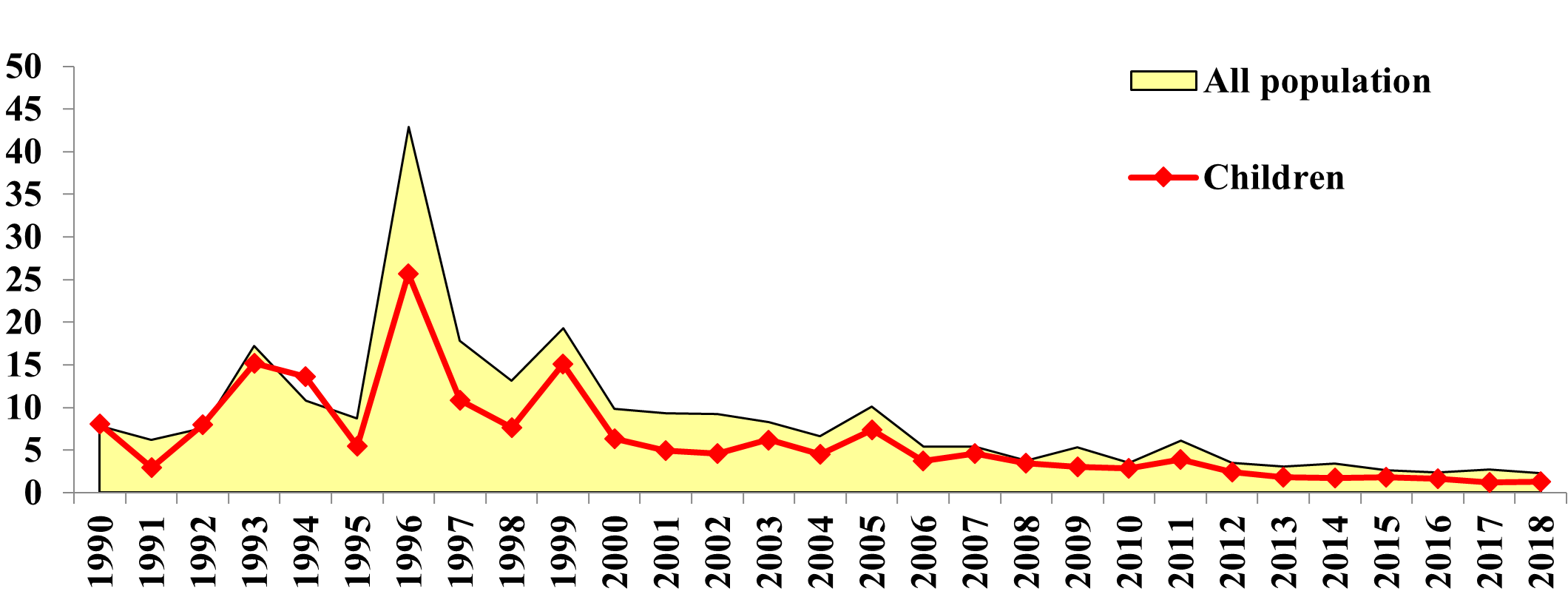
| 1990-1996 | 1997-2001 | 2002-2008 | 2008 to present |
| Selective specific TBE vaccination – immunization of the occupational risk groups | Adult population mass TBE vaccination | Routine children ≥ 7 years of age vaccination and mass immunization of adults | Universal routine vaccination of children from 15 months of age and mass immunization of adults |
| Uptake 30% | Uptake 55% | Uptake 76% | Uptake 87% |
The tactics of universal routine immunization of the population over the age of 15 months in combination with “catch-up” immunization of adults provided an increase in the level of vaccination against TBE from 35 to 87% (Fig. 5) and led to an TBE incidence decrease. 98% TBE vaccination field effectiveness in 2016 (Fig 6).36,39,40
Figure 6: TBE incidence in vaccinated and unvaccinated persons in 2000-2016 in Sverdlovsk region (per 100 000 vaccinated / unvaccinated populations)
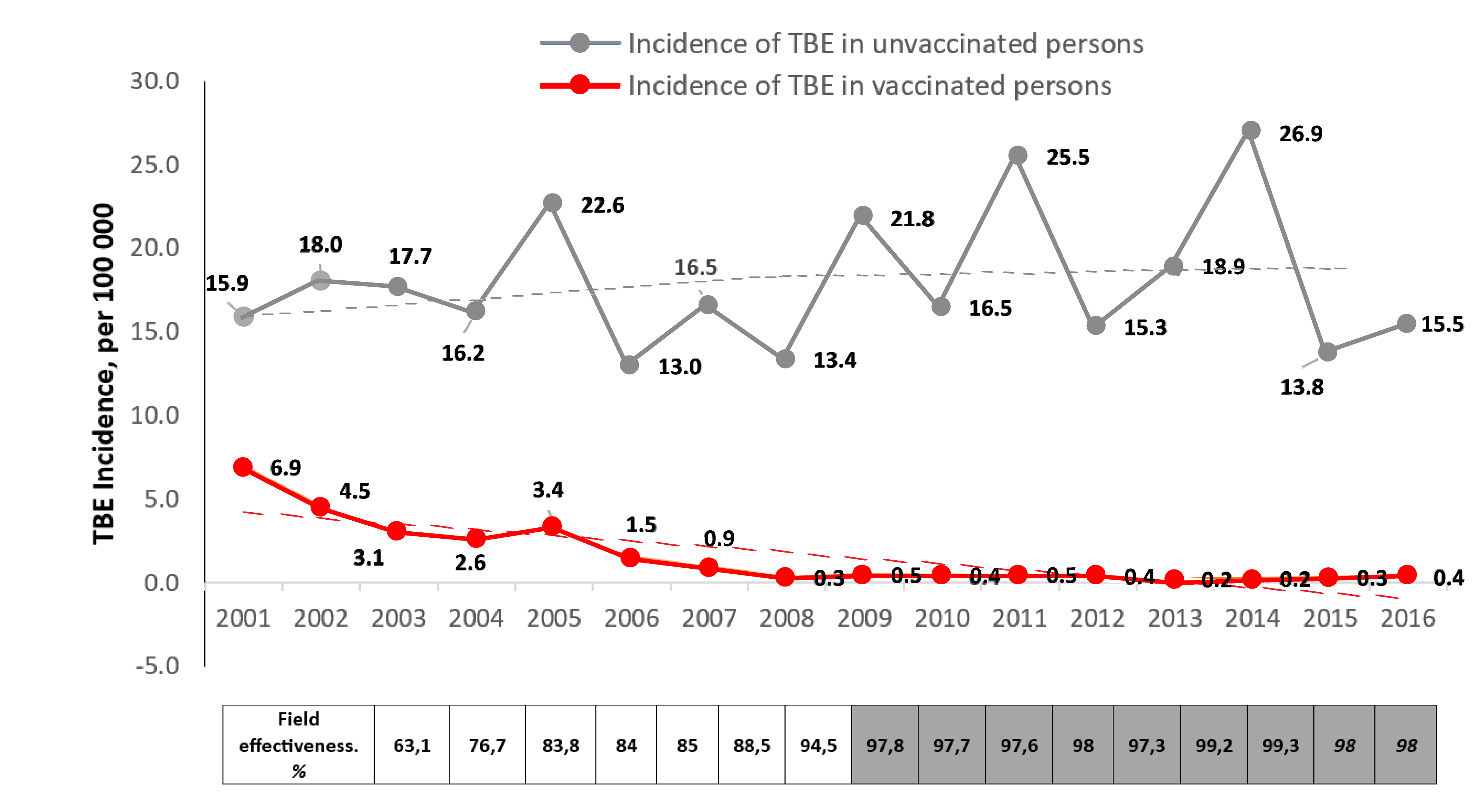
Contact
Sergey Tkachev
sergey.e.tkachev@gmail.com
Authors
Sergey Tkachev, Maria Esyunina and Maria Syrochkina
Citation
Tkachev S, Esyunina M, Syrochkina M. TBE in Russia. Chapter 13. In: Dobler G, Erber W, Bröker M, Chitimia-Dobler L, Schmitt HJ, eds. The TBE Book. 7th ed. Singapore: Global Health Press; 2024. doi:10.33442/26613980_13-27-7
References
- Chumakov MP. Tick-transferred spring-summer encephalitis in the European part of the USSR and Western Siberia. Zoolog J. 1940;19(2):335
- Zilber LA. [To the history of Far-East encephalitis investigations]. Vopr Virusol. 1957;(6):323-331
- Pogodina VV. [A path to true history]. Vopr Virusol. 2007;52(5):5-8
- Zlobin VI. [TBE: etiology, epidemiology and prevention problems in the beginning of the XXI century]. Ural Medical Journal. 2006; 6-11
- Pogodina VV. [Memories of Elizabeth Nikolaevna Levkovich]. Moscow. 2001
- Volkova LI. [Pathomorphosis of acute TBE in the Sverdlovsk region]. PhD thesis. Perm. 2001;34
- Volkova LI, Romanenko VV, Struin NL, et al. [Epidemiology, etiology, clinical presentation, diagnosis, treatment and prevention of TBE. Methodological instructions].Yekaterinburg. 2004
- Smorodintsev AA, Dubov AV. [TBE and its prevention by vaccination]. Leningrad:Medicine]. 1986
- Smorodintsev AA, Levkovich EN, Dankovskiy NL. [Epidemiological effectiveness of active immunization against TBE]. JMEI. 1941;4:12
- Levkovich EN, Zasukhina GD, Chumakov, et al. [Tissue culture vaccine against TBE]. Vopr Virusol. 1960;2:233-236
- Lvov DK. [Immunoprophylaxis of TBE]. Doctoral dissertation. Moscow. 1965
- Bilalova GP, Bystritsky LD, Vorobyova MS, Krasilnikov IV. [The history of vaccine production for the prevention of tick-borne encephalitis in the city of Tomsk: from brain vaccine to EnceVir vaccine]. Bull. Sib. Dep. RAMS. 2007;4:105-110
- Vorovich MF, Hapchaev Yu Kh, Prilukova NS, Nagirieva LI, Grachev VP. [Russian inactivated dry vaccine against tick-borne encephalitis]. Biomedicines. 2004;2(14):17-20
- Gerasimov SG, Druzhinina TA, Karan LS, et al. [Features of TBE in the Yaroslavl region at the present stage. The problem of the evolution of infection]. Epidemiol Infect Dis. 2014;19(4):37-44
- Glinsky NP, Kokorev VS, Patsuk NV, Kuchkova EV, Gogoleva OYu. [Tick-borne encephalitis: epidemiology, clinic, diagnosis, prevention]. Yekaterinburg. AMB Publishing House. 2006
- Danchinova GA, Khasnatinov MA, Zlobin VI. [Ixodid ticks in the south of Eastern Siberia and Mongolia and their spontaneous infection with pathogens of natural focal transmissible infections]. Bulletin of Siberian Medicine. 2006; 5(1):137-143
- Alekseev AN, Dubinina EV, Yushkova OV. [Functioning of “tick-causative agents” parasitic system in conditions of increasing anthropogenous pressure]. S-Peterburg: Insanta. 2008
- Korenberg EI, Pomelova VG, Osin NS. [Natural focal infections transferred by Ixodes ticks]. Мoscow. 2013
- Korenberg E, Likhacheva T. Analysis of the long-term dynamics of tick-borne encephalitis (TBE) and ixodid tick-borne borrelioses (ITBB) morbidity in Russia. Zentralbl Bakteriol. 2006;296(S1):54–58. doi:10.1016/j.ijmm.2006.02.001
- Shchuchinova LD, Kozlova IV, Zlobin VI. Influence of altitude on tick-borne encephalitis infection risk in the natural foci of the Altai Republic, Southern Siberia. Ticks Tick Borne Dis. 2015;6(3):322-329. doi:10.1016/j.ttbdis.2015.02.005
- Kholodilov I, Belova O, Burenkova L, et al. Ixodid ticks and tick-borne encephalitis virus prevalence in the South Asian part of Russia (Republic of Tuva). Ticks Tick Borne Dis. 2019;10(5):959-969. doi:10.1016/j.ttbdis.2019.04.019
- Morozov VG, Krasnobaev YP, Burenkova LA, et al. [Epidemiologic characteristic of the natural focuses of tick-borne encephalitis and borreliosis in the Zhiguli reserve territory]. Samar Luka Probl Reg Glob Ekol. 2009;18:106-112
- Rar V, Livanova N, Tkachev S, et al. Detection and genetic characterization of a wide range of infectious agents in Ixodes pavlovskyi ticks in Western Siberia, Russia. Parasit Vectors. 2017;10(1):258. doi:10.1186/s13071-017-2186-5
- Rar V, Livanova N, Sabitova Yu, et al. Ixodes persulcatus/pavlovskyi natural hybrids in Siberia: Occurrence in sympatric areas and infection by a wide range of tick-transmitted agents. Ticks Tick Borne Dis. 2019;10(6):101254. doi:10.1016/j.ttbdis.2019.05.020
- Demina TV, Dzhioev YP, Verkhozina MM, et al. Genotyping and characterization of the geographical distribution of tick-borne encephalitis virus variants with a set of molecular probes. J Med Virol. 2010;82(6):965-976. doi:10.1002/jmv.21765
- Zlobin VI, Verkhozina MM, Demina TV, et al. [Molecular epidemiology of tick-borne encephalitis]. Vopr Virusol. 2007;52(6):4-9
- Zlobin VI, Demina TM, Mamaev LV, et al. [Analysis of TBEV genetic variability by the primary structure of the surface E-protein gene]. Vopr Virusol. 2001;1:13-16
- Tkachev SE, Fomenko NV, Rar VA, Igolkina YP, Kazakova YV, Chernousova NY. PCR-detection and molecular-genetic analysis of tick-transmitted pathogens in patients of Novosibirsk region, Russia. Int J Med Microbiol. 2008;298:365-367. doi:10.1016/j.ijmm.2007.12.010
- Demina TV, Tkachev SE, Kozlova IV, et al. Comparative analysis of complete genome sequences of European subtype tick-borne encephalitis virus strains isolated from Ixodes persulcatus ticks, long-tailed ground squirrel (Spermophilus undulatus), and human blood in the Asian part of Russia. Ticks Tick Borne Dis. 2017;8(4):547-553. doi:10.1016/j.ttbdis.2017.03.002
- Kozlova IV, Demina TV, Tkachev SE, et al. Characteristics of the Baikal subtype of tick-borne encephalitis virus circulating in Eastern Siberia. Acta Biomedica Scientifica. 2018;3(4):53–60. doi:10.29413/ABS.2018-3.4.9
- Ruzek D, Avšič Županc T, Borde J, et al. Tick-borne encephalitis in Europe and Russia: Review of pathogenesis, clinical features, therapy, and vaccines. Antiviral Res. 2019;164:23-51. doi:10.1016/j.antiviral.2019.01.014
- Andaev EI, Nikitin AY, Tolmacheva MI, et al. [Epidemiological Situation on Tick-Borne Viral Encephalitis in the Russian Federation in 2022 and Forecast of its Development for 2023]. Problemy Osobo Opasnykh Infektsii. 2023;1:6–16. doi:10.21055/0370-1069-2023-1-6-16
- Rospotrebnadzor. [On the state of sanitary and epidemiological well-being of the population of the Russian Federation the in 2022]. Accessed March 29, 2024. https://rospotrebnadzor.ru/documents/details.php?ELEMENT_ID=25076
- Rospotrebnadzor. [About the sanitary-hygiene wellbeing of the population of the Russian Federation in 2017]. Accessed March 29, 2024. http://rospotrebnadzor.ru/documents/details.php?ELEMENT_ID=10145
- Rospotrebnadzor. [About the sanitary-hygiene wellbeing of the population of the Russian Federation in 2018]. Accessed March 29, 2024. https://www.rospotrebnadzor.ru/bitrix/redirect.php?event1=file&event2=download&event3=gosudarstvennyy-doklad-zashchita-prav-potrebiteley-v-rossiyskoy-federatsii-v-2018-godu.pdf&goto=/upload/iblock/332/gosudarstvennyy-doklad-zashchita-prav-potrebiteley-v-rossiyskoy-federatsii-v-2018-godu.pdf
- Rospotrebnadzor. [On the state of sanitary and epidemiological well-being of the population of the Russian Federation the in 2019]. Accessed March 29, 2024. https://www.rospotrebnadzor.ru/documents/details.php?ELEMENT_ID=14933
- Rospotrebnadzor. [About the sanitary-hygiene wellbeing of the population of the Russian Federation in 2016]. Accessed March 29, 2024. http://www.rospotrebnadzor.ru/bitrix/redirect.php?event1=file&event2=download&event3=gosudarstvennyy-doklad-2016.pdf&goto=/upload/iblock/0b3/gosudarstvennyy-doklad-2016.pdf
- Esyunina MS. [Current trends in the incidence of tick-borne encephalitis in various tactics of vaccination and the improvement of epidemiological surveillance and control]. PhD dissertation. Perm. 2015
- Rospotrebnadzor. [On the state of sanitary and epidemiological well-being population in the Sverdlovsk region in 2017]. Accessed March 29, 2024. http://www.66.rospotrebnadzor.ru/c/document_library/get_file?uuid=0091fbe2-bfaa-4cc0-9eaa-1e8a91053b58&groupId=10156
- Rospotrebnadzor. [On the state of sanitary and epidemiological well-being population in the Sverdlovsk region in 2018]. Accessed March 29, 2024. http://www.66.rospotrebnadzor.ru/c/document_library/get_file?uuid=cffb1abc-98c1-48aa-8a30-044b2b04c2c1&groupId=10156
